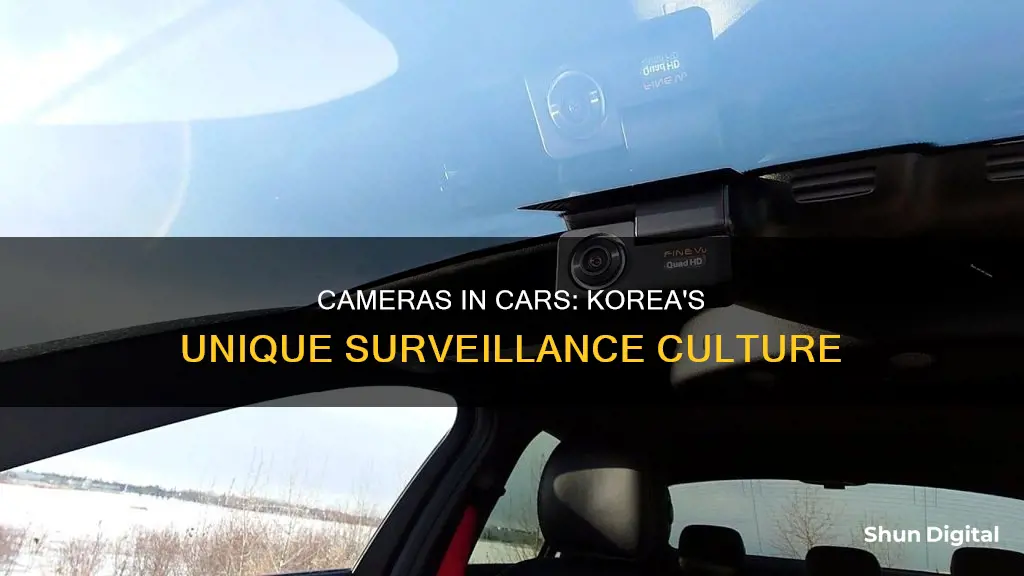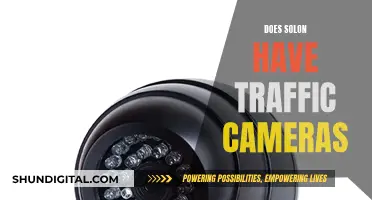
In South Korea, dashboard cameras, also known as black boxes, are extremely common. They are used to provide proof of who is to blame in traffic accidents and to prevent insurance fraud. The majority of South Korean car owners use them primarily for insurance purposes, as insurers offer discounts on monthly premiums for cars equipped with black boxes. The devices are also used to prevent scammers from throwing themselves onto the windscreens of slow-moving cars to claim insurance money.
| Characteristics | Values |
|---|---|
| Country | South Korea |
| Purpose | To prevent insurance fraud, provide evidence in case of accidents, and to deter scammers |
| Common names | "Black boxes" or "dashcams" |
| Cost | €130 for simple front-pointing cams, upwards of €350 for four-way cams |
| Insurance discount | Up to 5% |
| Installation | Usually on the windshield |
| Data collection | Footage, speed, location, etc. |
What You'll Learn

To prevent insurance scams by scammers who throw themselves onto cars
In South Korea, dashboard cameras, also known as "black boxes," are extremely popular. The vast majority of South Korean car owners use them, primarily for insurance purposes. The cameras act as evidence in the event of a crash, and insurance companies offer discounted monthly premiums to car owners who use them.
The popularity of dashboard cameras in South Korea can be attributed in part to their effectiveness in preventing insurance scams. Specifically, they serve as a deterrent to scammers who throw themselves onto the windscreens of slow-moving cars in an attempt to claim insurance money. This type of fraud is not unique to South Korea, but it has been a significant enough problem to prompt many drivers to install dashboard cameras in their cars.
The use of dashboard cameras has helped to combat this issue by providing video evidence that can refute false claims and clearly establish the facts of an accident, such as the speed of the vehicles involved, the actions of the drivers, and the surrounding road and weather conditions.
In addition to insurance purposes, dashboard cameras can also capture unexpected events, such as natural disasters and meteorites, as well as provide evidence of reckless driving. The footage from these cameras has spawned an amusing genre of videos and has contributed to the growing trend of dashboard cameras around the world.
Uncovering Surveillance: Can They Hear, Too?
You may want to see also

To provide evidence in the event of a crash
In South Korea, cameras in cars, or dash cams, are primarily used to provide evidence in the event of a crash. These dash cams are often referred to as "black boxes" and are used to determine who is at fault in traffic accidents. The majority of South Korean car owners use these devices for insurance purposes, as they can be used to support insurance claims. Additionally, some insurance companies offer discounted monthly premiums for cars equipped with dash cams.
The use of dash cams as evidence in the event of a crash is not limited to South Korea. In Singapore, for example, the country's largest taxi firm has installed cameras in all 16,600 of its vehicles to provide evidence after accidents and to encourage safe driving. Similarly, in France, the popularity of dash cams has been attributed to their use after accidents and in hit-and-run situations.
The presence of dash cams can also act as a deterrent to certain types of insurance fraud. In both Russia and South Korea, for instance, there have been cases of scammers deliberately jumping in front of slow-moving cars to claim insurance money. Dash cams have been effective in preventing such fraudulent activities.
Dash cams come in various types, ranging from simple front-facing cameras to more advanced four-way cameras that cover multiple angles. The cost of these devices can vary, with front-pointing cams priced around €130 and more comprehensive systems costing upwards of €350.
Overall, the use of dash cams in South Korea is a practical measure to provide evidence and support insurance claims in the event of a crash, promoting safer driving and reducing fraud.
Is My Camera Hacked? Signs to Watch Out For
You may want to see also

To prevent hit-and-run incidents
In South Korea, dashboard cameras, also known as "black boxes", are commonly installed in cars to prevent hit-and-run incidents and help with insurance claims. These cameras are known to deter hit-and-run drivers from fleeing the scene of an accident and provide valuable evidence to determine fault in traffic accidents.
According to a 2019 survey in South Korea, an overwhelming majority of respondents agreed that dashboard cameras deterred hit-and-run incidents and helped prevent traffic crimes, with over 92% expressing agreement. The presence of a camera discourages drivers from leaving the scene of an accident without taking responsibility for their actions.
In addition to preventing hit-and-run incidents, the cameras also serve as a protective measure for drivers themselves. They provide proof of what happened in the event of a crash, reducing the likelihood of drivers being taken advantage of or falsely blamed. This evidence can be used to support insurance claims and ensure a fair resolution for all parties involved.
The popularity of dashboard cameras in South Korea has led to their widespread use, with the majority of South Korean car owners equipping their vehicles with these devices. The cameras are so common that they are often referred to as "black boxes," reflecting their essential role in enhancing road safety and providing peace of mind for drivers.
The impact of dashboard cameras extends beyond South Korea, with a growing trend seen in other parts of the world, including Europe, Asia, and the United States. Many drivers are recognizing the benefits of these devices in providing evidence after accidents and promoting responsible driving behaviour. As a result, dashboard cameras are becoming an increasingly common feature in vehicles globally, contributing to improved road safety and accountability.
The Evolution of Camera Materials: From Wood to Plastic
You may want to see also

To deter reckless driving
Dashboard cameras, or "dashcams", are extremely popular in South Korea, with the vast majority of car owners using them. The cameras are primarily used for insurance purposes, providing evidence in the event of a crash. This helps to deter scammers who throw themselves onto the windscreens of slow-moving cars in an attempt to claim insurance money.
The use of dashcams can also help to deter reckless driving. In South Korea, dashcam footage is often used to settle insurance claims, but it can also be fed to activist websites that shame reckless drivers by posting videos of their dangerous driving online. This two-fold use of dashcam footage as both an insurance tool and a public shaming device helps to encourage safer driving habits and reduce the number of accidents on the road.
The effectiveness of dashcams in deterring reckless driving has been recognised by various organisations and authorities. For example, Singapore's largest taxi firm has installed cameras in all of its 16,600 vehicles not just to provide evidence after an accident but also to encourage prudence from drivers. Similarly, a French drivers' association called 40 Millions d'Automobilistes has advocated for dashcams to become standard equipment in all vehicles, with their head, Pierre Chasseray, stating that "it's an extremely positive development in terms of road safety and it's good in terms of ensuring drivers act responsibly".
The use of dashcams can also help to improve road safety by providing valuable data and insights on driving behaviour and accident causes. For example, the National Highway Traffic Safety Administration in the United States has been using data from car black boxes to collect car accident data since the early 2000s. This data can be used to identify trends and patterns in driving behaviour that can inform the development of more effective road safety measures and driver education programmes.
Overall, the presence of dashcams in cars in Korea serves as a powerful tool for deterring reckless driving and improving road safety. By providing a means to hold drivers accountable for their actions, whether through insurance claims or public scrutiny, dashcams help to encourage safer driving habits and reduce the risk of accidents on the road.
Surveillance Camera Positioning: Optimal Security Coverage
You may want to see also

To record accidents and natural disasters
In South Korea, cameras in cars, known as "black boxes", have become extremely popular. The majority of South Korean car owners use these dash cams for insurance purposes, as they provide proof of who is to blame in traffic accidents. Insurance companies offer discounted monthly premiums to car owners who use dash cams. This is particularly useful in a country that experiences a variety of natural disasters, from earthquakes and tsunamis to floods and landslides.
Dash cams can capture crucial footage of natural disasters and their aftermath. For example, a dashcam recorded the 2011 Japanese earthquake and tsunami, with some people using their vehicles as makeshift boats. Another video shows a driver navigating through a blizzard, with visibility reduced to just a few feet. Hurricanes, wildfires, and tornadoes are also intense events that dash cams have recorded. These recordings provide a unique perspective on natural disasters, making the events feel more real and immediate to viewers.
In addition to natural disasters, dash cams in South Korea are also used to record accidents and deter scammers. "Crash for cash" schemes, where scammers deliberately throw themselves onto car windscreens to claim insurance money, are less likely to occur when there is video evidence from a dashcam. This has made dash cams extremely popular in South Korea, with the majority of car owners now using them.
The use of dash cams has spread beyond South Korea, with growing popularity in other Asian countries, Europe, and the United States. They are particularly useful in countries with high rates of traffic accidents or insurance fraud. Dash cams provide valuable evidence after an accident and can also encourage drivers to act more responsibly and adhere to rules.
Polaroid Camera Battery: Where is it Located?
You may want to see also
Frequently asked questions
Cameras in cars, also known as "dashcams" or "black boxes", are used primarily for insurance purposes. They provide proof of who is at fault in traffic accidents and can help to prevent insurance fraud.
In Korea, if you hit a person with your car, it is common cultural practice for them to try to get as much money as possible by staying in the hospital for as long as possible, even if their injuries are minor. Dashcams can help to protect drivers from this type of insurance scam.
Dashcams are extremely common in Korea, with the vast majority of South Korean car owners using them. They are also mandatory in all new vehicles since 2014.
Yes, most car insurance companies in Korea offer a discount of up to 5% on insurance for cars equipped with dashcams.







